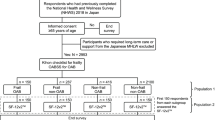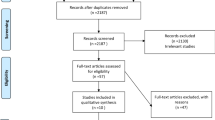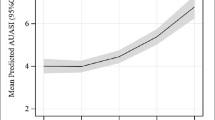Abstract
Purpose
Urinary incontinence (UI) and frailty are common geriatric syndromes. Although literature increasingly supports a relationship between these two conditions, no systematic review and meta-analysis has been performed on this topic. Therefore, we aimed to investigate the potential association between UI and frailty, through a meta-analytic approach.
Methods
A systematic search in major databases was undertaken until 15th March 2018 for studies reporting the association between UI and frailty. The prevalence of UI in people with frailty (vs. those without) was pooled through an odds ratio (OR) and 95% confidence intervals (CIs), with a random-effects model. The other outcomes were summarized descriptively.
Results
Among 828 papers, 11 articles were eligible, including 3784 participants (mean age 78.2 years; 55.1% women). The prevalence of UI was 39.1% in people with frailty and 19.4% in those without. A meta-analysis with five studies (1540 participants) demonstrated that UI was over twice as likely in frail people versus those without (OR 2.28; 95% CI 1.35–3.86; I2 = 61%). One cross-sectional study, adjusting for potential confounders and one longitudinal study confirmed that UI is significantly associated with frailty. In two cross-sectional studies, using adjusted analyses, frailty was more common in people with UI.
Conclusion
Urinary incontinence is twice as common in older people with frailty compared to older people without frailty. Screening and the development of interventions for UI and frailty could prove useful for this common comorbidity.


Similar content being viewed by others
References
Aharony L, De Cock J, Nuotio MS, Pedone C, Rifel J, Vande Walle N, Velghe A, Vella A, Verdejo-Bravo C (2017) Consensus document on the management of urinary incontinence in older people. Eur Geriatr Med 8:202–209
Suskind AM (2017) Frailty and lower urinary tract symptoms. Curr Urol Rep 18:67
Cesari M, Calvani R, Marzetti E (2017) Frailty in older persons. Clin Geriatr Med 33:293–303
Junius-Walker U, Onder G, Soleymani D, Wiese B, Albaina O, Bernabei R, Marzetti E, ADVANTAGE JA WP4 group (2018) The essence of frailty: a systematic review and qualitative synthesis on frailty concepts and definitions. Eur J Intern Med. https://doi.org/10.1016/j.ejim.2018.04.023
Verdejo-Bravo C (2012) Geriatric Urinary Incontinence: special concerns on the frail elderly. En Urinary Incontinence, pp 113–130
Collard RM, Boter H, Schoevers RA, Oude Voshaar RC (2012) Prevalence of frailty in community-dwelling older persons: a systematic review. J Am Geriatr Soc 60(8):1487–1492
Inouye SK, Studenski S, Tinetti ME, Kuchel GA (2007) Geriatric syndromes: clinical, research, and policy implications of a core geriatric concept. J Am Geriatr Soc 55:780–791
Gibson W, Wagg A (2014) New horizons: urinary incontinence in older people. Age Ageing 43:157–163
Chong E, Chan M, Lim WS, Ding YY (2018) Frailty predicts incident urinary incontinence among hospitalized older adults—a 1-year prospective cohort study. J Am Med Dir Assoc 19:422–427
von Elm E, Altman DG, Egger M, Pocock SJ, Gøtzsche PC, Vandenbroucke JP (2008) The strengthening the reporting of observational studies in epidemiology (STROBE) statement: guidelines for reporting observational studies. J Clin Epidemiol 61(4):344–349
Liberati A, Altman DG, Tetzlaff J, Mulrow C, Gøtzsche PC, Ioannidis JPA, Clarke M, Devereaux PJ, Kleijnen J, Moher D (2009) The PRISMA statement for reporting systematic reviews and meta-analyses of studies that evaluate health care interventions: explanation and elaboration. PLoS Med 6(7):e1000100
Katz S, Downs TD, Cash HR, Grotz RC (1970) Progress in development of the index of ADL. Gerontologist 10(1):20–30
Rockwood K, Black S, Bedard MA, Tran T, Lussier I (2007) Specific symptomatic changes following donepezil treatment of Alzheimer’s disease: a multi-centre, primary care, open-label study. Int J Geriatr Psychiatry 22(4):312–319
Fried LP, Tangen CM, Walston J, Newman AB, Hirsch C, Gottdiener J, Seeman T, Tracy R, Kop WJ, Burke G, McBurnie MA (2001) Frailty in older adults: evidence for a phenotype. J Gerontol Ser A Biol Sci Med Sci 56(3):M146–M156
Wells GA, Shea B, O’connell D, Peterson J, Welch V, Losos M, Tugwell P (2014) The Newcastle–Ottawa Scale (NOS) for assessing the quality of nonrandomised studies in meta-analyses. Ottawa Hospital Research Institute. http://www.ohri.ca/programs/clinical{_}epidemiology/oxford.asp. Accessed 13 Aug 2014
Luchini C, Stubbs B, Solmi M, Veronese N (2017) Assessing the quality of studies in meta-analyses: advantages and limitations of the Newcastle Ottawa Scale. World J Meta Anal 5:80–84
DerSimonian R, Laird N (1986) Meta-analysis in clinical trials. Control Clin Trials 7(3):177–188
Higgins JPT, Thompson SG (2002) Quantifying heterogeneity in a meta-analysis. Stat Med 21(11):1539–1558
Higgins JP, Green S (2008) Cochrane handbook for systematic reviews of interventions. Cochrane Book Series. Wiley
Egger M, Smith GD, Schneider M, Minder C (1997) Bias in meta-analysis detected by a simple, graphical test measures of funnel plot asymmetry. BMJ 315:629–634
Duval S, Tweedie R (2000) Trim and fill: a simple funnel-plot-based method of testing and adjusting for publication bias in meta-analysis. Biometrics 56:455–463
Wang C-J, Hung C-H, Tang T-C, Chen L-Y, Peng L-N, Hsiao F-Y, Chen L-K (2017) Urinary incontinence and its association with frailty among men aged 80 years or older in taiwan: a cross-sectional study. Rejuvenation Res 20(2):111–117
Berardelli M, De Rango F, Morelli M, Corsonello A, Mazzei B, Mari V, Montesanto A, Lattanzio F, Passarino G (2013) Urinary incontinence in the elderly and in the oldest old: correlation with frailty and mortality. Rejuvenation Res 16(3):206–211
Kang L, Zhang S-Y, Zhu W-L, Pang H-Y, Zhang L, Zhu M-L, Liu X-H, Liu Y-T (2015) Is frailty associated with short-term outcomes for elderly patients with acute coronary syndrome? J Geriatr Cardiol 12(6):662
Calado LB, Ferriolli E, Moriguti JC, Martinez EZ, da Lima NK (2016) Frailty syndrome in an independent urban population in Brazil (FIBRA study): a cross-sectional populational study. Sao Paulo Med J 134(5):385–392
Goeteyn J, Evans LA, De Cleyn S, Fauconnier S, Damen C, Hewitt J, Ceelen W (2017) Frailty as a predictor of mortality in the elderly emergency general surgery patient. Acta Chir Belg 117(6):370–375
Jung HW, Jang IY, Lee YS, Lee CK, Il Cho E, Kang WY, Chae JH, Lee EJ, Kim DH (2016) Prevalence of frailty and aging-related health conditions in older Koreans in rural communities: a cross-sectional analysis of the aging study of pyeongchang rural area. J Korean Med Sci 31(3):345–352
Erekson EA, Fried TR, Martin DK, Rutherford TJ, Strohbehn K, Bynum JPW (2015) Frailty, cognitive impairment, and functional disability in older women with female pelvic floor dysfunction. Int Urogynecol J Pelvic Floor Dysfunct 26(6):823–830
Matsushita E, Okada K, Ito Y, Satake S, Shiraishi N, Hirose T, Kuzuya M (2017) Characteristics of physical prefrailty among Japanese healthy older adults. Geriatr Gerontol Int 17(10):1568–1574
Bilotta C, Casé A, Nicolini P, Mauri S, Castelli M, Vergani C (2010) Social vulnerability, mental health and correlates of frailty in older outpatients living alone in the community in Italy. Aging Mental Health 14(8):1024–1036
Chang CI, Chan DC, Kuo KN, Agnes Hsiung C, Chen CY (2011) Prevalence and correlates of geriatric frailty in a Northern Taiwan community. J Formos Med Assoc 110(4):247–257
Wagg A, Gibson W, Ostaszkiewicz J, Johnson T, Markland A, Palmer MH, Kuchel G, Szonyi G, Kirschner-Hermanns R (2015) Urinary incontinence in frail elderly persons: report from the 5th international consultation on incontinence. Neurourol Urodyn 34(5):398–406
Acknowledgements
Special Interest Group on UI includes: L. Aharony, Community Geriatric Service, Haifa and Western Galilei District, Calit Health Services, Haifa, Israel; J. De Cock, Geriatric Department, Universitair Ziekenhuis Brussel, Brussels, Belgium; M.S. Nuotio, Seina¨sjoki Central Hospital, Seina¨sjoki, Finland; C. Pedone, Universita` Campus Bio-Medico di Roma, Rome, Italy; J. Rifel, University of Ljubljana, Faculty of Medicine, Family Medicine Department, Ljubljana, Slovenia; N. Vande Walle, Geriatric Department, Universitair Ziekenhuis Brussel, Brussels, Belgium; A. Velghe, Department of Geriatric Medicine, Ghent University Hospital, Gent, Belgium; A. Vella, Department of Geriatric Medicine, Malta Medical School, University of Malta, Msida, Malta.
Special Interest Group of Systematic reviews and meta-analysis for healthy ageing includes: M. Solmi, University of Padova, Padova, Italy; A. Koyanagi, Parc Sanitari Sant Joan de Déu/CIBERSAM, Universitat de Barcelona, Fundació Sant Joan de Déu, Sant Boi de Llobregat, Barcelona, Spain; T. Thompson, Faculty of Education and Health, University of Greenwich, London, United Kingdom; C. Beudart, Department of Public Health, Epidemiology and Health Economics, University of Liege, Liege, Belgium; O. Bruyère, Department of Public Health, Epidemiology and Health Economics, University of Liege, Liege, Belgium; G. Torbahn, Institute of Social Paediatrics and Adolescent Medicine, LMU Munich, Munich, Germany; J. Firth, NICM, School of Science and Health, University of Western Sydney, Australia; Division of Psychology and Mental Health, University of Manchester, UK; L. Smith, The Cambridge Centre for Sport & Exercise Sciences, Anglia Ruskin University, Cambridge, UK.
Funding
This work was not supported by any funding.
Author information
Authors and Affiliations
Consortia
Corresponding author
Ethics declarations
Conflict of interest
The authors declare that they have no conflict of interest.
Ethical approval
This article does not contain any studies with human participants or animals performed by any of the authors.
Informed consent
None.
Additional information
The members of the Special Interest Group on Urinary Incontinence and the Special Interest Group of Systematic Reviews and Meta-Analysis for Healthy Aging, European Geriatric Medicine Society (EuGMS) are listed below in the acknowledgements.
Electronic supplementary material
Below is the link to the electronic supplementary material.
Rights and permissions
About this article
Cite this article
Veronese, N., Soysal, P., Stubbs, B. et al. Association between urinary incontinence and frailty: a systematic review and meta-analysis. Eur Geriatr Med 9, 571–578 (2018). https://doi.org/10.1007/s41999-018-0102-y
Received:
Accepted:
Published:
Issue Date:
DOI: https://doi.org/10.1007/s41999-018-0102-y




